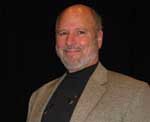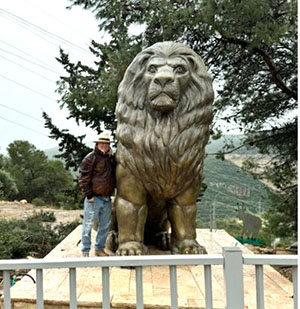By Jerry Klinger


NESHER, Israel — At the turn-off from HeHaruv Street in the City of Nesher, a giant Lion greets visitors on their way to hike Nesher Park. Two almost football-length suspension bridges connect Nesher Park to the back side of Haifa across a deep ravine. The steel-cabled narrow walkways shake and swing gently above the chasm 70 feet below of Nahal Katia.
Nahal Katia is normally a dry stream bed. It can become a torrential river during the winter rains. The ravine funnels waters from the Carmel Mountain chain above downward, nourishing the biblical heart of Israel.
The Park is a beautiful escape, a turn to a natural Israeli woodland setting where oak, terebinth, and Greek strawberry trees are abundant. Pines, planted by early Zionist reforesting hands, fill in the gaps. A children’s playground, benches, and vistas complete the overall pleasant setting.
Some hikers are enthused by the narrow, shaky challenge beneath their feet; others are thoroughly frightened. They can’t or won’t see their way across.
Nesher Park is a wonderful escape into nature, an escape from cares and concerns that lets hikers think about something other than disheartening current events.
The Park is a JNF/KKL project. The City of Nesher maintains the Park and controls the land.
The City of Nesher has gentrified its name, Nesher, from the biblical Hebrew, meaning (the Griffin) vulture, to the more acceptable, noble name of “Eagle” today. The Griffin is a giant, powerful bird with a wingspan of easily 8 feet. In ancient times, it was the symbol of royalty used by the Egyptians and Mesopotamians, who incorporated the Griffin into their battle standards. It is still called the King of the Birds by many.
Vulture is not culturally politically correct. Eagle is. English biblical translations prefer to use the word “Eagle.”
In his 1902 fictional outline for the new Jewish state, Altneuland, the Old New Land, Theodor Herzl wrote, “The plan for building a homeland for the Jewish people must also take into consideration the founding of a Hebrew cement factory.”
Cement is needed to build a house or a city. The Carmel and nearby Kishon Valley region contain significant deposits of primary natural materials for cement. Resources are fine. To build a country, a Homeland for the Jewish people, as the 1917 Balfour Declaration called for, a cement factory had to be built. There was none in British Mandatory Palestine.
In 1919, seven Jewish businessmen formed the Palestine Portland Cement Syndicate in London. They purchased land from Palestinian landowners, the Khoury family, near present-day Yagur and built the Nesher Portland Cement Factory.
The modern city of Nesher was begun as a worker’s residential community supporting the Nesher cement works. Nesher was sited on poor land, swampy and malarial, challenges the Jews had and did overcome.
The Nesher Cement factory stimulated economic life in the previously moribund region. It provided work to both Jews and Arabs. The factory grew. The city of Nesher grew, as did the nearby Arab city of Balad al-Sheikh.
Animosity and tensions between Arabs and Jews grew. Tensions were fueled by cultural distances in Palestine since the 1880s. Bloody, violent, anti-Jewish, anti-Zionist xenophobic outbreaks were led by Islamic fundamentalists. Nesher and Jewish settlements suffered.
The 1929 Arab Riots against the British and Jews saw the Nesher factory attacked, nearby Jewish farms burned, and more Jewish lives lost. Many of the attackers came from Balad al-Sheikh. Into the 1930s, the British were unable to control the situation. Jewish self-defense and response to Arab attacks came into being.
Izz ad-Din al-Qassam was a Syrian Muslim/Palestinian religious leader. He organized violent attacks against French and British rule in the Levant in the 1920s and 1930s. He was rabidly anti-Jewish, anti-Zionist.
Qassam was killed in a British counter-terror operation in 1935 near Jenin. He is buried in the Muslim Cemetery of Balad al-Sheikh. His gravesite is a shrine to some. The Palestinian homemade rockets used to attack Jewish communities indiscriminatingly killing Jews are named after him – Quassams.
During the 1948 War of Independence, the population of Balad al-Sheikh fled. Jews took over Balad al-Sheikh, incorporating the village area into modern Nesher.
Roi Levi, mayor of Nesher, heard of the Lion’s Trail shortly after the shock of the genocidal attacks of October 7 rocked all of Israel. He approached Sam Philipe and the Jewish American Society for Historic Preservation (JASHP) to see if a Lion could come to Nesher.
JASHP’s positive answer to Nesher was influenced by thoughts of the Nesher Park bridges and the ghoulish kidnapping of bodies of murdered Jews.
In 2007, JASHP brought home to Israel the remains of Stephen Norman. Norman was the abandoned last descendant of Theodor Herzl, his grandson. Ironically, Norman was the only Herzl to have ever been to Mandate Palestine, to have ever been a Zionist, and to have ever wanted to return.
He was permanently barred by the British in 1946 from returning to help build the State of Israel, specifically because he was a Herzl. The British would not permit a potential symbol of Zionism to return to Mandate Palestine.
That year, Chaim Weizmann obtained a small job for Norman in the British Embassy in Washington, far from Israel. It was there that he learned his family had been exterminated in the Holocaust. He learned of the languishing survivors; refugees stuck in European DP camps with nowhere to go. Norman became deeply depressed that he, a Herzl, could do nothing for them.
It was a crisp, early November morning. Norman walked to the Massachusetts Avenue Bridge, spanning Rock Creek 70 feet below. It was an ironic location. Today, the Bridge’s southern end is the location of Washington’s Islamic Mosque and Cultural Center, and the northern end is the British Embassy.
Norman was trapped between the intransigence of the Arabs and the heartlessness of the British.
He folded his tweed jacket, neatly draping it over the Bridge railing, and leaped to his death.
It was 18 months since the end of the Holocaust and 18 months before the birth of Modern Israel. Norman could not see in the early morning of his personal darkness. Norman was buried in an obscure gravesite in a lonely Jewish cemetery in Washington, D.C. He was left behind. He was forgotten.
JASHP brought him home to Israel to be reburied with his family in the plot for Zionist Leaders on Mt. Herzl in Jerusalem. Bringing him home was the right thing to do. It was not easy. Norman had not remembered his grandfather’s admonition. “If you believe it, it need not be a dream.”
October 7, Israel endured the genocidal murder of anything Jewish by Hamas. Over 200 captives, even bodies of dead, were kidnapped into Gaza.
A terrible resolve was forced on Israel to bring them home and defeat the Hamas monsters of death. Roi Levi wanted a Lion, a giant powerful Lion’s Trail for Nesher. The answer was Yes.
The plaque on the Nesher lion reads:
“Saul and Jonathan…they were swifter than eagles, they were stronger than lions”…
(Samuel 2, 1:23)
The Jewish people have lived here for over 3,000 years.
Donated by the Jewish American Society for Historic Preservation in cooperation with the Nesher municipality
Sam Philipe Sculptor January 2024
*
Jerry Klinger is the President of the Jewish American Society for Historic Preservation.
www.JASHP.org.